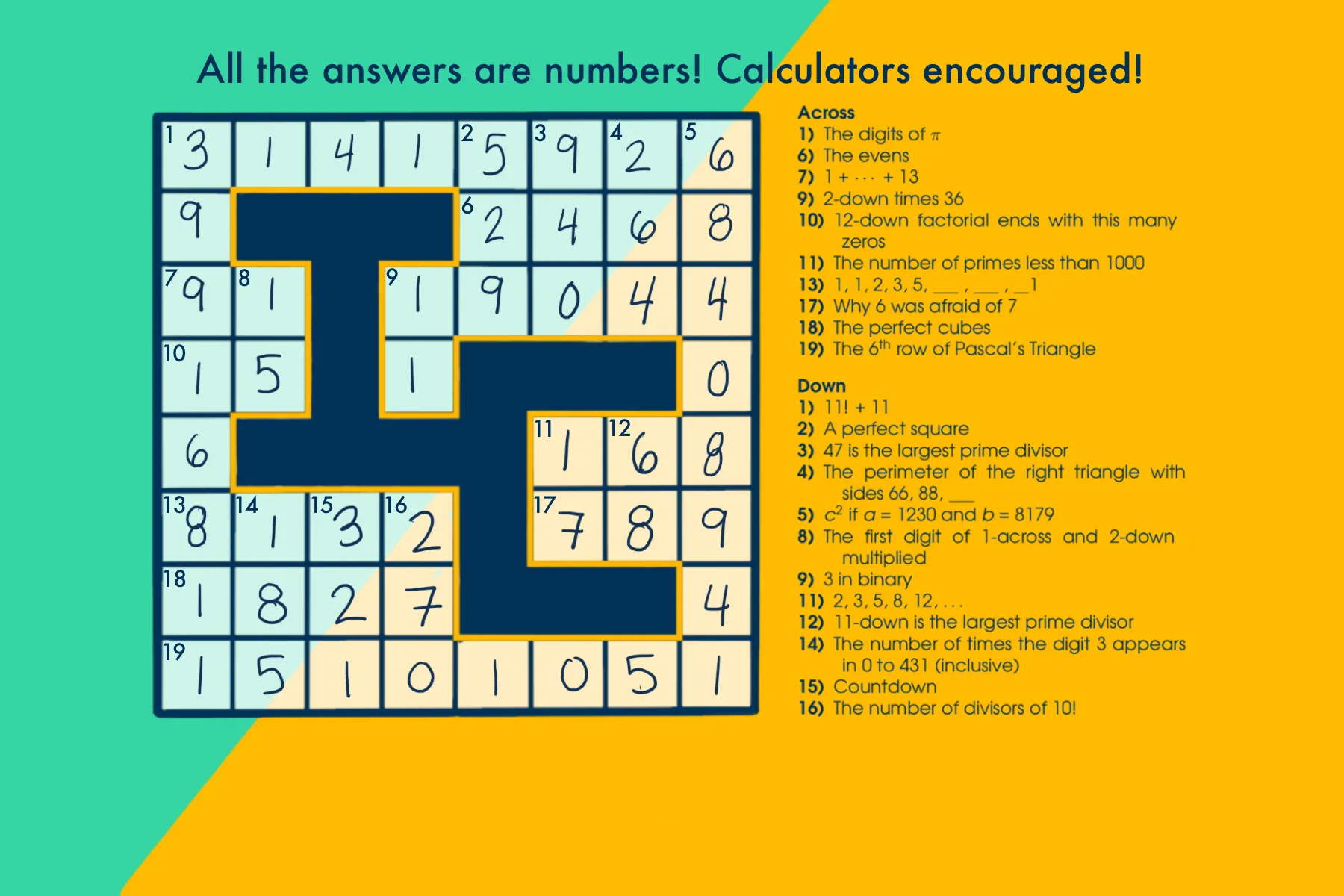Across
1) The digits of pi are readily available, but some people have made a point of memorizing that auspicious number. Akira Haraguchi has recited 100,000 digits of pi in 16 hours!
6) Even numbers are those that can be written as 2n for an integer n.
7) 1+...+13 = 91. You may have just done this in your calculator or by hand, but there is actually a formula for this! Modern folklore tells us that this formula was discovered by a school-aged Gauss when his teacher assigned the tedious assignment of adding the numbers 1 through 100 by hand (in order to gain a half and hour of break). The legend goes that Gauss quickly realized you could rearrange the sum: (1+100)+(2+99)+...+(50+51) = 101*50=101*100/2=5050. This quickly leads us to the formula 1+2+...+n=n(n+1)/2. (Is this story true? Perhaps.)
10) In general, how can we figure out how many zeros n! ends with? You need to figure out how many factors of 10 there are (or the minimum of the number of 2 and 5 factors). With some careful counting, you can do this without a calculator!
11) Primes are the very basis of our integers. However, there is no known formula for consistently finding primes, though that's not for lack of trying. We do know that there are infinitely many prime numbers and finding new, large primes is incredibly intensive (check out the current largest known prime here!). To solve this one, you probably need a little help from the internet.
13) 1, 1, 2, 3, 5 is the start of the very famous Fibonacci sequence: F(1)=F(2)=1 and F(n)=F(n-1)+F(n-2). There is so much going on with the Fibonacci sequence, and it shows up all around us in the world. While this is the answer, there are actually over a thousand known number sequences that begin this way! For any numerical sequence, you can enter the beginning into the Online Encyclopedia of Integer Sequences and see all the sequences that match.
17) But why did 7 eat 9? To get 3 squared meals a day.
18) A perfect cube is a number n such that n can be written as a^3 for some integer a.
19) Pascal's triangle is a numerical array of what is know as the "binomial coefficients." While that sounds complicate, it is relatively straightforward to set-up. Not only that, it has many amazing patterns embedded among it's numbers!
Down
1) A calculator would be a good idea to calculate 11!+11. But if you did it by hand - kudos!
2) A perfect square is a number n such that n can be written as a^2 for some integer a. But fun fact: did you know that any row of Pascal's triangle will sum to a power of 2?
3) A prime divisors is a prime that divides our number. But alone, this isn't enough info. With a few numerals filled in and some "guess and check" you should be able to track down a number that is a multiple of 47 and fits the spot.
4) This one requires the Pythagorean theorem - that famous fact of right triangles side-lengths. But did you know that the theorem was known much earlier than it was published by Pythagoras in the 6th Century BCE. There is evidence that this relationship was understood in ancient Babylon and Egypt much earlier than this.
5) More Pythagorean theorem!
9) Binary is the base 2 number system and only uses the digits 0 and 1. You start counting: 0, 1, 10, 11, 100, 101,.... Binary is used by computers but did you know that it was also used to multiply in ancient Egypt?
11) 2, 3, 5, 8, 12,... Notice the difference between each of these terms: 2+1=3, 3+2=5, 5+3=8, 8+4=12. So, 12+5=17. If we check-out the Online Encyclopedia of Integer Sequences, though there are 128 sequences that begin this way (at the time of writing....this is always changing as we discover new sequences).
16) Counting divisors of 10! comes down to looking at the factors or each of 1, 2, 3, 4, 5, 6, 7, 8, 9, 10. The prime factorization of 10! is 10!=(2^8)(3^4)(5^2)(7^1). So, any divisor of 10! will look like (2^a)(3^b)(5^c)(7^d) where "a" can be 0 through 8, "b" can be 0 through 4, "c" can be 0 through 2, and "d" can be 0 or 1. So there are 9*5*3*2=270 divisors.
